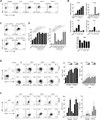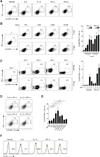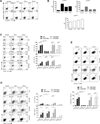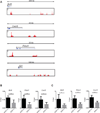Type I IFN induces binding of STAT1 to Bcl6: divergent roles of STAT family transcription factors in the T follicular helper cell genetic program
- PMID: 24489092
- PMCID: PMC3967131
- DOI: 10.4049/jimmunol.1300675
Type I IFN induces binding of STAT1 to Bcl6: divergent roles of STAT family transcription factors in the T follicular helper cell genetic program
Abstract
CD4(+) T follicular helper cells (TFH) are critical for the formation and function of B cell responses to infection or immunization, but also play an important role in autoimmunity. The factors that contribute to the differentiation of this helper cell subset are incompletely understood, although several cytokines including IL-6, IL-21, and IL-12 can promote TFH cell formation. Yet, none of these factors, nor their downstream cognate STATs, have emerged as nonredundant, essential drivers of TFH cells. This suggests a model in which multiple factors can contribute to the phenotypic characteristics of TFH cells. Because type I IFNs are often generated in immune responses, we set out to investigate whether these factors are relevant to TFH cell differentiation. Type I IFNs promote Th1 responses, thus one possibility was these factors antagonized TFH-expressed genes. However, we show that type I IFNs (IFN-α/β) induced B cell lymphoma 6 (Bcl6) expression, the master regulator transcription factor for TFH cells, and CXCR5 and programmed cell death-1 (encoded by Pdcd1), key surface molecules expressed by TFH cells. In contrast, type I IFNs failed to induce IL-21, the signature cytokine for TFH cells. The induction of Bcl6 was regulated directly by STAT1, which bound to the Bcl6, Cxcr5, and Pdcd1 loci. These data suggest that type I IFNs (IFN-α/β) and STAT1 can contribute to some features of TFH cells but are inadequate in inducing complete programming of this subset.
Figures





Similar articles
-
Identification of novel markers for mouse CD4(+) T follicular helper cells.Eur J Immunol. 2013 Dec;43(12):3219-32. doi: 10.1002/eji.201343469. Epub 2013 Oct 14. Eur J Immunol. 2013. PMID: 24030473 Free PMC article.
-
Cutting edge: STAT1 is required for IL-6-mediated Bcl6 induction for early follicular helper cell differentiation.J Immunol. 2013 Apr 1;190(7):3049-53. doi: 10.4049/jimmunol.1203032. Epub 2013 Feb 27. J Immunol. 2013. PMID: 23447690 Free PMC article.
-
Expansion of T follicular helper-T helper 1 like cells through epigenetic regulation by signal transducer and activator of transcription factors.Ann Rheum Dis. 2018 Sep;77(9):1354-1361. doi: 10.1136/annrheumdis-2017-212652. Epub 2018 May 31. Ann Rheum Dis. 2018. PMID: 29853448
-
Transcriptional regulation of follicular T-helper (Tfh) cells.Immunol Rev. 2013 Mar;252(1):139-45. doi: 10.1111/imr.12040. Immunol Rev. 2013. PMID: 23405901 Free PMC article. Review.
-
Role of TRAFs in Signaling Pathways Controlling T Follicular Helper Cell Differentiation and T Cell-Dependent Antibody Responses.Front Immunol. 2018 Oct 22;9:2412. doi: 10.3389/fimmu.2018.02412. eCollection 2018. Front Immunol. 2018. PMID: 30405612 Free PMC article. Review.
Cited by
-
Precocious Interleukin 21 Expression in Naive Mice Identifies a Natural Helper Cell Population in Autoimmune Disease.Cell Rep. 2017 Oct 3;21(1):208-221. doi: 10.1016/j.celrep.2017.09.036. Cell Rep. 2017. PMID: 28978474 Free PMC article.
-
Human tonsil organoids reveal innate pathways modulating humoral and cellular responses to ChAdOx1.PLoS Pathog. 2025 Aug 22;21(8):e1013432. doi: 10.1371/journal.ppat.1013432. eCollection 2025 Aug. PLoS Pathog. 2025. PMID: 40845053 Free PMC article.
-
RACK1 enhances STAT3 stability and promotes T follicular helper cell development and function during blood-stage Plasmodium infection in mice.PLoS Pathog. 2024 Jul 18;20(7):e1012352. doi: 10.1371/journal.ppat.1012352. eCollection 2024 Jul. PLoS Pathog. 2024. PMID: 39024388 Free PMC article.
-
TIR-Domain-Containing Adapter-Inducing Interferon-β (TRIF) Regulates CXCR5+ T helper Cells in the Intestine.J Clin Cell Immunol. 2016 Oct;7(5):458. doi: 10.4172/2155-9899.1000458. Epub 2016 Sep 30. J Clin Cell Immunol. 2016. PMID: 27853628 Free PMC article.
-
Human Immunodeficiency Virus Playing Hide-and-Seek: Understanding the TFH Cell Reservoir and Proposing Strategies to Overcome the Follicle Sanctuary.Front Immunol. 2017 May 31;8:622. doi: 10.3389/fimmu.2017.00622. eCollection 2017. Front Immunol. 2017. PMID: 28620380 Free PMC article. Review.
References
-
- Abbas AK, Murphy KM, Sher A. Functional diversity of helper T lymphocytes. Nature. 1996;383:787–793. - PubMed
-
- Miller JF, De Burgh PM, Grant GA. Thymus and the production of antibody-plaque-forming cells. Nature. 1965;208:1332–1334. - PubMed
-
- Friedman H. Absence of Antibody Plaque Forming Cells in Spleens of Thymectomized Mice Immunized with Sheep Erythrocytes. Proc Soc Exp Biol Med. 1965;118:1176–1180. - PubMed
-
- Crotty S. Follicular helper CD4 T cells (TFH) Annual review of immunology. 2011;29:621–663. - PubMed
Publication types
MeSH terms
Substances
Grants and funding
LinkOut - more resources
Full Text Sources
Other Literature Sources
Molecular Biology Databases
Research Materials
Miscellaneous

